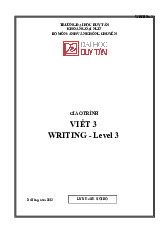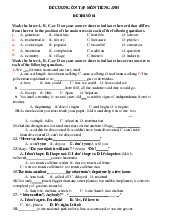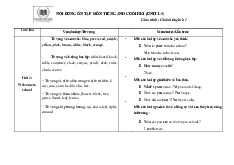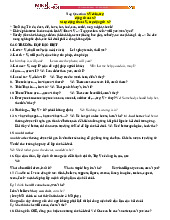


Preview text:
lOMoAR cPSD| 46836766
UNIT 3: EDUCATION – TEXT3
INVESTMENT IN EDUCATION AND TRAINING
The role of education and training
The revolution of the world’s science and technology is happening quickly. Science
has become a direct productive force and the technology is renovated very quickly.
Intellectual level and scientific, and technological potential have returned become a
factor determining the power and position of each country in the world.
Education standard is always considered one of the most important criteria for
assessing the development level of society. Education plays a crucial role in
enhancing people’s knowledge, workforce training, and fostering talents for the country.
For poor countries like Vietnam, investment in human resources in general,
education and training in particular is the only way to escape from poverty and
backwardness. In other words, human resources development is the key for Vietnam
to escape from poverty and backwardness.
Changes and achievements
Since the country was reunited, the Vietnamese Communist Party and government
have made great efforts to overhaul the education system throughout the country.
During the school year 1980-1981, Vietnam first adopted 12 curricula, and in 1992
the whole curriculum and new textbooks had been completed.
The current national education system in Vietnam includes preschool education with
nurseries and kindergartens. Formal schooling has two levels primary education
(from grade 1 to grade 5) and secondary education (from grade 6 to grade 12) which
has lower and upper secondary education; vocational education with specialized
school and vocational training, and tertiary education.
The literacy elimination campaign has gained encouraging achievement. Vietnam
has one of the lowest illiteracy rates in the world. Forms of training have been
diversified with full-time, in-service, and distance training to meet the ever-rising
needs of learners as well as the whole society. Moreover, more and more Vietnamese
students are sent abroad to study further.
The program content and teaching methods have been enhanced to develop qualified
students to meet the demands of the market economy. Long-term and short-term lOMoAR cPSD| 46836766
vocational schools are opened for high school graduates to prepare for the labor market.
In recent years, although state budget investment in education has been limited, it
has still increased steadily to give a big chance of financial advantage for the
development of education and training. The work of strengthening and expanding
the educational network in mountainous and remote provinces has achieved initial positive results.
Problems exist in Vietnamese education:
Teaching equipment is outdated. Currently, equipment of the pre-1960 generation
still accounts for 37% of the total equipment available in universities and colleges.
In common schools, the deterioration of schools and classrooms is even worse. The
practice of third-shift classes and temporary classrooms is common in localities.
The qualifications of teachers at all levels are still low, unable to meet the high
requirements of today's economic development. Low income forces many teachers
to quit teaching or spread extra classes for economic purposes, decreasing the
reputation of schools in general and teachers in particular in people’s eyes.
The polarization of education quality is an aching issue in Vietnam. Although the
policy of socializing education has created more educational opportunities, there are
risks of widening social gaps. The problem of “genuine diploma, fake knowledge”
is currently a thorny issue in Vietnam.
Education spending per capita is still very low compared to other countries in the
region and the world. In the coming time, Vietnam’s education won’t be able to
develop unless education spending per capita does not increase.
The source of stage budget investment in education and training fails to meet the
demand and offset unexpected costs due to the increase in the number of students
(on average more than one million children/year), due to inflation, … Meanwhile,
many experts in the field of education argue that the education budget allocation on
a population scale is unreasonable and has significantly affected training quality.
How do we overcome this situation?
According to a senior official of the Ministry of Education and Training, it is
necessary to increase financial resources for education and training, up to 20% of
the state budget in particular. lOMoAR cPSD| 46836766
Vietnam’s Communist Party and the State need to focus all efforts, giving the top
priority to education and training development which should be considered the
leading national policy of the Government and the cause of the entire people.
It is essential to complete illiteracy education nationwide and universalize primary
education at the right age in most localities, towards basically universalizing
secondary education around 2020.
In conclusion, various methods should be adopted to socialize education intensively
and extensively. It is necessary to enhance the investment efficiency of limited
capital in education budget management mechanisms.




